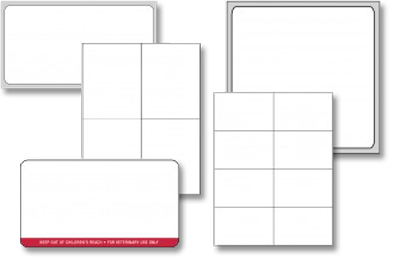Requirements For Veterinary Medication Dispensing Labels
Newly developed drugs and custom-compounding medications improve the health and well being of animals each day. And, when medications are prescribed for owners to administer to their pets, the FDA mandates specific medication labeling requirements. For example, the veterinarian's prescription must include:
- Name and address of the dispenser
- Serial number and date of the order or its filling
- Name and address of the veterinarian who prescribed or ordered the drug product
- Directions for use
- Any necessary warning and precautionary statements including withdrawal times
Further, this information should also appear on the label of the dispensed product.
Medication Labels Guide Proper Use For Pet Owners
Veterinary prescription labels guide the proper administration and use of medications. In fact, they assist pet owners, communicating proper storage and caregiving, once their pet is at home.
Unclear medical abbreviations, confusing dosing instructions and poor penmanship are common causes of improper medication dispensing. For instance, a puzzled pet owner is more likely to dispense medications improperly. But, a clearly printed label with clear instructions is proven to significantly reduce these types of errors.
Medication Labels Guide Proper Use For The Veterinary Staff
Furthermore, medication labels help the veterinary staff dispense medications safely and accurately.
A number of drug names have similar spellings or sound very similar. For example, the brand name drugs, “Convenia” and “Cerenia,” may look-alike on written orders. And, SINEQUAN and ZENIQUIN sound-alike when communicated verbally.
In addition, although the FDA has taken steps to reduce confusion created by similar looking drug labels, there are still issues that can cause problems. For example, a brand that introduces a new product often uses similar packaging. But, the new product may serve a different purpose than the original. Unfortunately, confirmation bias, based on the use of that original product, makes misuse of that medication more likely.
Making Veterinary Medication Dispensing More Efficient WIth Labels
Today, many veterinary practices generate medication dispensing labels using desktop thermal and laser label printers. Using a medication label format designed for the specific printer and a print-ready format will increase the ease and accuracy of label printing. Plus, it allows you to easily comply with FDA medication label requirements.
Furthermore, using warning labels including Look-alike, Sound-alike and Tallman help you differentiate medications. In fact, they provide a visual alarm that alerts your staff. So does labeling the medication with both the generic and trade name.
In fact, medication dispensing labels are an effective safeguard against accidental inappropriate use.
United Ad Label
United Ad Label specializes in developing labels that enhance practice communication and safeguard your staff and clients from medication errors. Browse our website or contact us to learn more.

